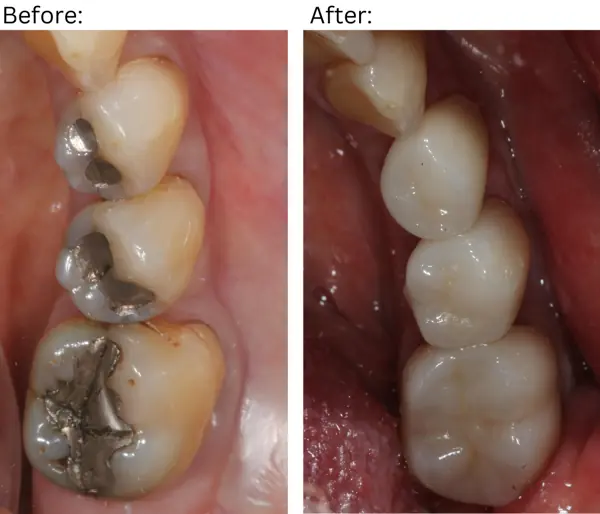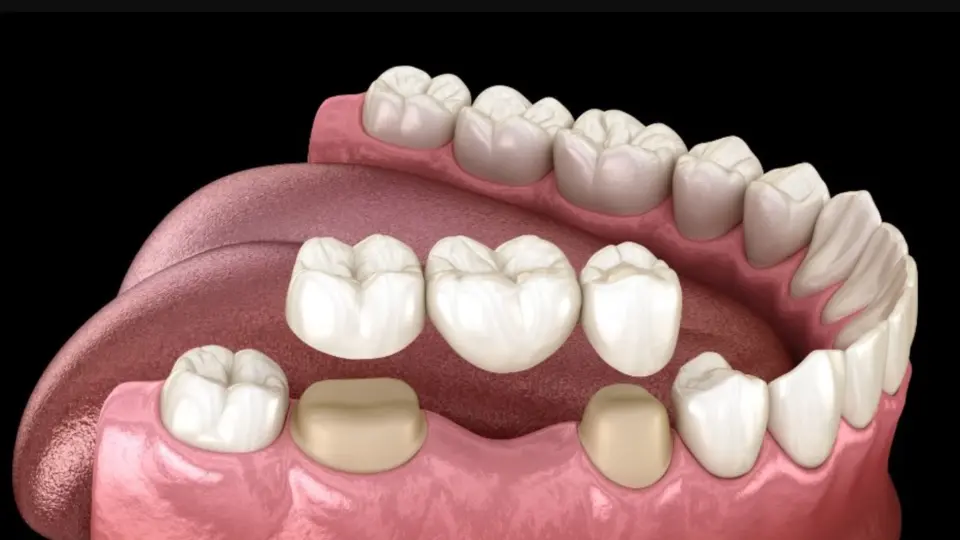Tooth Fillings in Pompano Beach FL | JB Dentistry
Discover Tooth Fillings in Pompano Beach FL with JB Dentistry
Whether you have cracked tooth syndrome or just a simple cavity, we can provide tooth fillings to strengthen your oral health.

tooth fillings
A tooth filling is a dental restorative material used to repair a tooth damaged by decay, fractures, or other forms of dental trauma. The filling material is placed in the prepared cavity of the tooth to restore its function, shape, and integrity. Common filling materials include composite resin, glass ionomer cement, amalgam, and gold. Depending on the material chosen, a filling may last several years or even decades before needing to be replaced.
Tooth fillings are generally easy procedures that can be completed quickly in one visit to your dentist’s office. Before beginning any treatment, your dentist will take an x-ray of the damaged tooth and discuss your treatment options with you.
Once the material has been selected, your dentist will prepare the affected site by removing any decay or damaged tissue from the tooth and cleaning it thoroughly. After that, they will place the filling material in the prepared cavity and shape it accordingly. Then, a polishing paste is applied to smooth out any rough edges from the filling material.
composite fillings
how long do composite fillings last?
Typically, composite fillings will remain intact for 5 to 7 years. However, this timeline can vary greatly depending on the placement of the filling and how much pressure it is under. Generally, if a tooth receives minimal stress from chewing or grinding, then the composite filling may last much longer than 5-7 years.
Composite fillings are also more likely to last longer if they are applied by a skilled dentist.
Dental hygiene is also an important factor in the longevity of composite fillings. Regular brushing and flossing help to reduce bacterial buildup, which can help preserve the integrity of the filling for longer. Additionally, avoiding foods that could damage the filling such as sticky or hard candy can extend its life span.


what is a composite filling made of?
Composite dental fillings consist of a mix of resin and powdered glass. This combination creates a strong, durable material that can withstand the pressures associated with normal chewing and biting. The resin gives composite fillings their strength, while the powdered glass provides a natural color that can match your teeth.
advantages & disadvantages of composite dental fillings
Composite dental fillings, also known as tooth-colored fillings, offer several advantages and disadvantages compared to other dental fillings. Here are some of the main advantages and disadvantages of composite dental fillings:
advantages of composite dental fillings
- Aesthetic Appeal: One of the significant advantages of composite fillings is their ability to blend in with the natural color of your teeth. They can be precisely matched to the shade of your existing teeth, making them virtually invisible. This makes composite fillings an excellent choice for filling cavities in visible areas of the mouth, such as the front teeth.
- Preservation of Natural Tooth Structure: Composite fillings require less removal of healthy tooth structure compared to other filling materials. The dentist can often preserve more of your natural tooth, which benefits long-term dental health.
- Versatility: Composite fillings can be used for both front and back teeth. They can effectively restore small to medium-sized cavities caused by decay or minor tooth damage.
- Bonding Strength: Composite fillings bond directly to the tooth structure. This bonding strength provides additional support and helps to strengthen the tooth, reducing the risk of further damage or fracture.
disadvantages of composite dental fillings
- Longevity: Compared to other filling materials, composite fillings may not be as durable or long-lasting, especially for larger cavities or areas of high biting force. They may wear down or chip over time and must be replaced more frequently.
- Staining: Composite fillings have the potential to stain or discolor over time, especially if exposed to staining substances like coffee, tea, or tobacco. Regular dental cleanings and good oral hygiene practices can help minimize staining.
- Cost: Composite fillings are more expensive than other fillers, such as amalgam (silver) fillings. The cost difference can vary depending on the size of the filling and the location of the tooth.
- Restoration Size Limitations: Composite fillings may not be suitable for larger restorations or areas with extensive tooth decay. Alternative materials like dental crowns or inlays/onlays may be recommended in such cases.
how long does a composite dental filling procedure take?
The composite dental filling procedure typically takes about an hour, depending on the size and location of the cavity. The dentist will first clean out the decay, then prepare the tooth for the filling. This may include shaping it to fit in with your other teeth.
Next, they’ll place a layer of adhesive material directly onto the tooth before adding several layers of composite resin. The dentist will use a light to harden each layer of the filling before adding more layers until the cavity is completely filled and the tooth is restored to its original shape.
Finally, they’ll finish by polishing the new composite dental filling for an even and natural look. With regular checkups, your composite fillings should last many years with proper care.
composite dental fillings repair & replacement
Composite dental fillings are popular for repairing tooth decay, minor fractures, and other types of tooth damage. While composite fillings can provide effective restoration, they may require repair or replacement under certain circumstances.
Here’s some information about the repair and replacement of composite dental fillings:
- Repair of Composite Fillings: In some cases, composite fillings can be repaired if damaged or worn. The repair process involves removing the damaged portion of the filling and replacing it with additional composite material.
- Replacement of Composite Fillings: Composite fillings, like any dental restoration, have a limited lifespan and may require replacement over time. The longevity of a composite filling can vary depending on factors such as the size of the filling, biting forces, oral hygiene practices, and personal habits (such as grinding or clenching teeth).
Reasons for replacing composite fillings may include:
- Wear and Tear: Over time, composite fillings can experience wear, degradation, or staining. This can occur due to normal chewing forces, grinding habits, or exposure to certain foods and beverages. If the filling becomes compromised or shows signs of deterioration, it may need to be replaced.
- Recurrent Decay: If decay develops around or beneath a composite filling, it may need to be replaced to remove the decayed tooth structure and provide a new, intact filling.
- Fracture or Damage: If a composite filling fractures, chips, or breaks, it may require replacement to restore the tooth’s function and integrity.
- Aesthetics: Patients may sometimes replace composite fillings for cosmetic reasons. They may desire a color change or improvement in the appearance of their teeth.
It’s important to attend regular dental check-ups, as your dentist will monitor the condition of your fillings and recommend replacement if necessary. During these check-ups, dentists like Jaline Boccuzzi, DMD, AAACD will assess the integrity and functionality of your fillings and address any concerns or issues.
ceramic fillings
Ceramic filling is a popular dental treatment that can help to restore function and strength in teeth affected by decay, fractures, or wear. This procedure involves placing a ceramic material into the cavity created by removing the damaged tooth structure and restoring it with a durable material. The materials used for this type of restoration are typically made from porcelain or other ceramic compounds. These materials are extremely strong and resilient, making them a great choice for restoring teeth damaged or weakened by disease or trauma.
ceramic tooth fillings repair & replacement
Ceramic tooth fillings, porcelain fillings, or inlays/onlays offer excellent durability and aesthetics. While they are known for their longevity, there are situations where repair or replacement may be necessary.
Here’s some information about the repair and replacement of ceramic tooth fillings:
Repair of Ceramic Fillings: In certain cases, ceramic fillings can be repaired if they sustain minor damage. Repair typically involves removing the damaged or chipped portion of the filling and replacing it with composite resin or a new ceramic material. Small cracks or chips can often be addressed through this repair procedure, restoring the integrity and appearance of the filling. However, the repair’s feasibility depends on the damage’s extent and location. Your dentist will assess the condition of the filling and determine if repair is a viable option.
Replacement of Ceramic Fillings: Ceramic fillings are known for their exceptional durability and resistance to wear. However, over time, they may require replacement due to various factors. The lifespan of a ceramic filling can vary depending on factors such as oral hygiene practices, grinding or clenching habits, biting forces, and the quality of the restoration itself.
Reasons for replacing ceramic fillings may include:
- Fracture or Severe Damage: If a ceramic filling sustains a significant fracture or damage that compromises its structural integrity, it may need to be replaced to restore the functionality and aesthetics of the tooth.
- Recurrent Decay: If decay develops around or beneath a ceramic filling, removing the decayed tooth structure and replacing the filling may be necessary to maintain the tooth’s health and prevent further damage.
- Wear or Deterioration: While ceramic fillings are highly resistant to wear, they may gradually wear down or become rough over time. In such cases, replacement may be recommended to restore a smooth surface and prevent potential issues.
- Aesthetics: Sometimes, patients may choose to replace ceramic fillings for cosmetic reasons. They may desire a color change or improvement in the appearance of their teeth.
Your dentist will evaluate the condition of your ceramic filling during routine dental check-ups and recommend replacement if necessary. By following good oral hygiene practices, including regular brushing, flossing, and attending dental check-ups, you can help prolong the lifespan of your ceramic fillings and minimize the need for repairs or replacements.
difference between ceramic & composite dental fillings
Ceramic fillings are made from composite resins that combine glass, quartz, and other fine particles to create a strong and durable material. Composite fillings are made of plastic-based materials like acrylic resin or porcelain. Ceramic fillings can be more aesthetically pleasing than composites because they come in different shades that can blend in with the natural color of your teeth.
They also tend to be more durable than composites and can last for many years, making them a good choice for larger fillings that need extra support. Composite fillings are usually not as strong or long-lasting as ceramic fillings. Still, they are often used for smaller cavities since they come in many shades that can match the natural color of your teeth.
As with all dental procedures, it is important to consult your dentist before deciding which type of filling is best for you. Your dentist can help you choose the right material and technique for your dental needs. In addition, ceramic and composite fillings require regular checkups to ensure they remain in place and functioning properly.
what to expect during a tooth filling
Once the tooth has been numbed, the dentist will use a drill or air abrasion instrument to remove the decayed area and clean out any bacteria that may be present. A composite resin material is then applied in layers and hardened with a special curing light. The dentist will shape and polish the filling to match your natural tooth, making it virtually indistinguishable from surrounding teeth. The entire process usually takes 30-60 minutes, and the filling should last several years.
After the procedure is finished, it’s important to practice good oral hygiene habits to keep your mouth healthy and your new tooth filling strong. This includes brushing twice a day with fluoride toothpaste, flossing regularly, rinsing with an antibacterial mouthwash, and visiting the dentist for regular check-ups. By following these simple steps, you can enjoy a beautiful smile for years to come!
benefits of tooth filling
Tooth fillings offer several benefits when restoring and maintaining oral health. Here are some key advantages of tooth fillings:
- Decay Removal: Tooth fillings are primarily used to treat tooth decay. They allow dentists to remove the decayed portion of a tooth and replace it with filling material, effectively stopping the progression of decay and preventing further damage to the tooth.
- Restoring Tooth Structure: Fillings help restore the structure and integrity of a tooth compromised by decay or minor fractures. Filling in the cavities or gaps left after decay removal, fillings help to rebuild the tooth’s natural shape, strength, and functionality.
- Prevention of Tooth Sensitivity: Dental decay often leads to tooth sensitivity, particularly when exposed to hot or cold stimuli. Fillings seal the affected area, providing a protective barrier that helps reduce or eliminate sensitivity.
- Preservation of Natural Teeth: Dentists can preserve more of the natural tooth structure by treating dental decay with fillings. This is advantageous because it allows patients to retain their natural teeth instead of resorting to more extensive treatments such as extractions or dental implants.
- Aesthetic Appeal: Modern dental fillings, such as composite resin fillings, can be color-matched to blend seamlessly with the natural shade of the teeth. This ensures a more aesthetically pleasing result, particularly when the filling is placed in a visible mouth area.
- Versatility: Fillings can treat both front and back teeth, making them versatile for restoring decayed or damaged teeth regardless of location.
- Durability: Dental fillings, when properly cared for, can be long-lasting and provide years of functionality. The lifespan of a filling can vary depending on factors such as the material used, the size and location of the filling, and individual oral hygiene practices.
- Improved Oral Health: By addressing dental decay and restoring tooth structure, fillings contribute to oral health. They prevent further decay and damage, which, if left untreated, could lead to more extensive dental problems.
It’s important to note that the benefits of tooth fillings may vary depending on the individual case and the filling material used. Your dentist can evaluate your needs and recommend the most appropriate filling material and treatment plan to restore and maintain your oral health effectively. At Jaline Boccuzzi, DMD, AAACD, let us take care of your tooth fillings needs. Contact us today!


